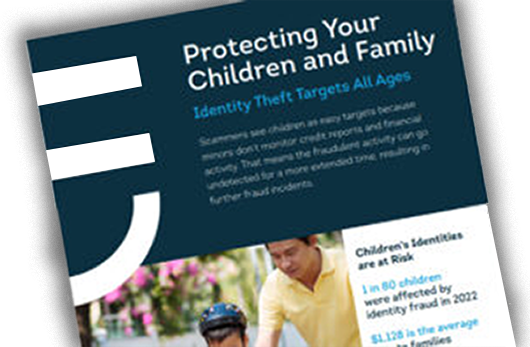Summary:
Identity thieves are interested in children’s identities because they are a blank slate; they don’t have a credit history. As a result, one out of 50 U.S. children are victims of identity fraud, with out-of-pocket expenses costing families nearly $1 billion annually.
Let’s look at the issue more closely and how you can help protect your children.
What is Child Identity Theft?
Child identity theft involves co-opting a minor’s personally identifiable information (PII), such as their Social Security number (SSN), to commit fraud. Children’s credit histories are clean slates and often remain unchecked for years, giving scammers ample time to commit fraud without being detected.
An identity thief can steal a legitimate SSN, add a different name, birth date, address and phone number, and start a new, fraudulent credit file. This process is known as synthetic identity theft.
How Does Child Identity Theft Happen?
Child identity theft can happen when a minor’s PII is misused by:
- A criminal with stolen information found on the dark web. Thieves often try to access a victim’s credit, as it grants opportunities to take out loans, open credit lines and commit other types of identity fraud under a new name.
- A family member or friend with easy access to the child’s personal information.
- A guardian, as kids in foster care can be at increased risk for identity theft.
Children’s information is collected many places, including social media platforms, school systems and healthcare providers. Their smart devices, video games and mobile applications are also gathering their information. Given the rise of data breaches, kids’ identities are increasingly at risk of being exposed on the dark web and online forums where identities are illegally bought and sold.
“Child fullz,” the name fraudsters use to refer to a child’s complete stolen information package, can be easily found for sale on the dark web. These “fullz” include names, dates of birth, addresses and Social Security numbers. Each packaged identity starts at $10 each or can be purchased in bulk for even less.
Here are just a few ways criminals can misuse children’s Social Security numbers:
- Apply for jobs
- Open bank and credit card accounts
- Apply for a loan or utility service, including a cell phone account
- Get out of a crime or arrest
- Apply for government benefits
What are the Warning Signs My Child’s Identity Has Been Stolen?
Child identity theft often goes unchecked and unnoticed for years, only to be discovered when your child starts to apply for loans or credit cards. Identity thieves use the child’s identity to take out new credit card accounts, obtain driver’s licenses, get a job and even buy homes and cars.
Warning signs that your child’s identity has been stolen:
- You receive a notice from the IRS regarding a tax return filed under your child’s name
- You are denied government benefits because your child’s Social Security number is attached to someone else’s benefit claim
- Your child receives credit card and loan offers.
- Collection calls and notices start targeting your child
What Do I Do if My Child is a Victim of Identity Theft?
Aside from the emotional stress of your child being a victim of identity theft, the financial damage can take years to repair. If you suspect your child has been the victim of identity theft:
- Check whether your child has a credit report with the three credit bureaus. If they do, you’ll want to report the fraud to the Federal Trade Commission, notify law enforcement, contact any companies where the fraudulent accounts are and initiate a dispute on the related accounts. TransUnion offers detailed guidance on how to respond.
- Request a credit freeze, also known as a security freeze, to make it harder for someone to open new accounts in your child’s name.
- Limit who has access to sensitive information — from family and friends to schools and healthcare providers. Take control and don’t feel pressured to provide sensitive information when completing certain forms. Additionally, ask how the information provided about your child is used and secured.
- Educate your child on the importance of safe online habits, especially when creating online accounts and using secure passwords.
- Monitor their information while they are young and consider getting identity theft protection to have an extra set of eyes monitoring your family’s personal information.
How Can I Protect My Child’s Identity?
Here are a few steps that you can take to protect yourself and your family against child identity theft:
- Understand where your child’s PII is stored, particularly at schools, dentists and medical offices. Ask how they secure their records: Are digital records connected to the internet and, if so, are they encrypted? Are physical records in locked in filing cabinets? Who has access?
- Ask how any PII you provide on school forms will be used and with whom it will be shared. Verify that these forms are updated and that it is truly required to provide PII about your child.
- Ask about the school’s directory information policy and what details about your child are included. You may have the choice to opt out.
- Consider a credit freeze for minors, available from all three major credit bureaus, which makes it more difficult for a fraudster to open new accounts with a child’s PII.
- Guard against scammers who use social media to target children’s identities with Social Media Identity Monitoring.
How To Protect Your Children And Family From Identity Theft





